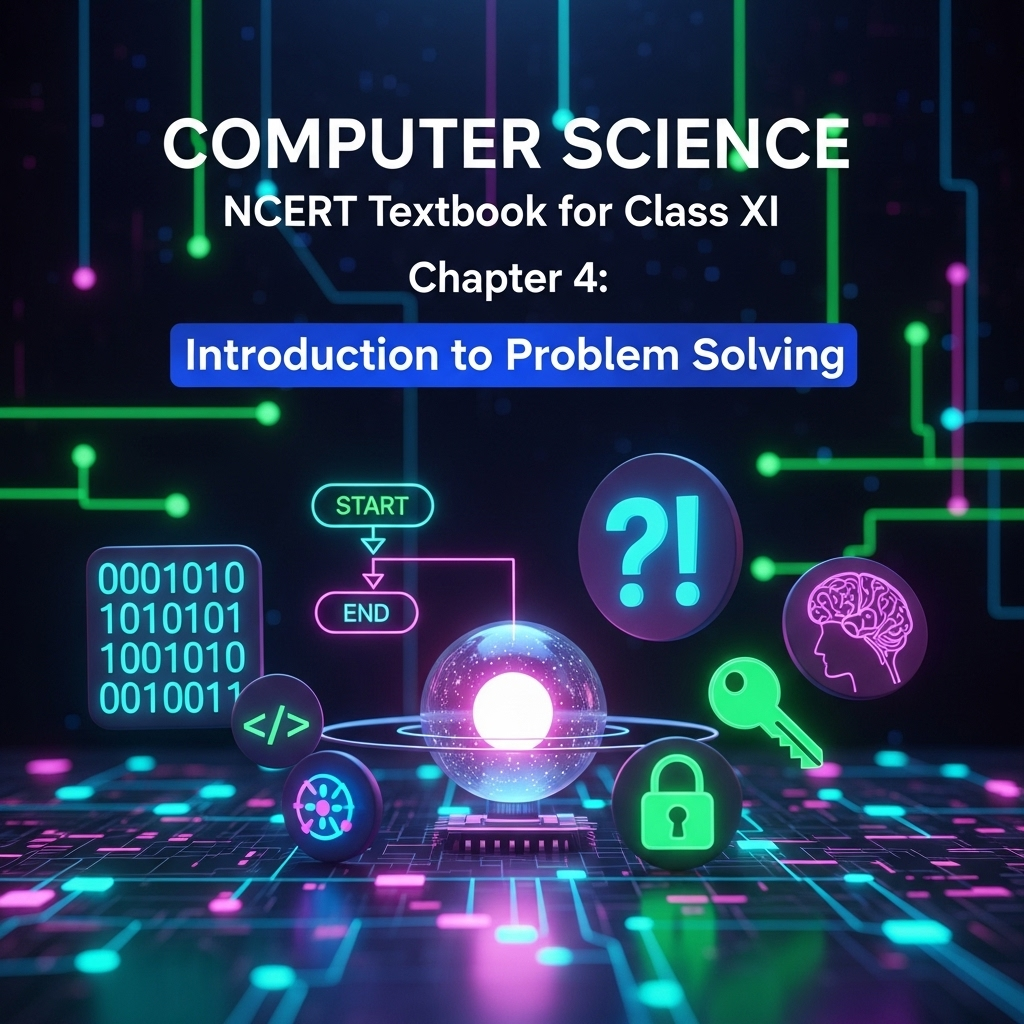Introduction to Problem Solving – NCERT Class 11 Computer Science Chapter 4 – Algorithms, Flowcharts, Pseudocode, and Control Structures
Introduces systematic approaches to problem solving using computers. Covers the stages of problem solving including analysis, algorithm design, coding, testing, and debugging. Explains representation of algorithms through flowcharts and pseudocode, flow of control in programs (sequence, selection, iteration), verification and comparison of algorithms, and the concept of decomposition for complex problems.
Updated: 1 month ago

Introduction to Problem Solving
Chapter 4: Enhanced NCERT Class 11 Guide | Expanded Precise Notes from Full PDF, Detailed Explanations, Diagrams, Examples & Quiz 2025
Enhanced Full Chapter Summary & Precise Notes from NCERT PDF (26 Pages)
Overview & Key Concepts
Exact Definition: "Problem solving is the process of identifying a problem, developing an algorithm for the identified problem and finally implementing the algorithm to develop a computer program."
- Introduction: Computers automate tasks like online train booking; GIGO principle. Quote: Aho & Ullman on abstraction.
- Chapter Structure: Steps (analyze/develop/code/test), Algorithm (characteristics), Representation (flowchart/pseudocode), Flow Control (sequence/selection/repetition), Verification (dry run), Comparison (time/space), Coding (high-level langs), Decomposition (break complex problems).
- 2025 Relevance: AI-assisted coding (e.g., GitHub Copilot for algorithms); Decomposition in microservices; Verification in ethical AI testing.
4.1 Introduction
Precise: Computers for faster/accurate tasks; Railway reservation example. Expanded: 2025 – AI optimizes bookings, handles 10M+ queries/day via decomposition.
4.2 Steps for Problem Solving
Exact: Analyze, Develop Algorithm, Coding, Testing/Debugging (Fig 4.1). Expanded: GIGO – Garbage In, Garbage Out; Iterative process for complex problems like vehicle noise.
Precise Fig 4.1: Steps for Problem Solving (Expanded SVG)
4.2.1 Analyzing the Problem
Precise: Understand inputs/outputs; List components. Expanded: For 2025 app dev, analyze user data privacy (GDPR compliance).
4.2.2 Developing an Algorithm
Precise: Natural language steps; Refine like recipe. Expanded: Multiple algorithms possible; Select efficient one.
4.2.3 Coding
Precise: Convert to high-level lang; Document. Expanded: Python/C++ common; 2025 – Low-code platforms speed up.
4.2.4 Testing and Debugging
Precise: Unit/integration testing; Maintenance post-delivery. Expanded: Agile testing cycles; Tools like JUnit for automation.
4.3 Algorithm
Exact: Finite sequence of steps (GCD example). Origin: Al-Khwarizmi. Expanded: Why? Roadmap for reliable programs; E.g., search engines use algorithms.
Precise GCD Example: Steps for 45 & 54 (SVG)
4.3.1 Why Need Algorithm? Characteristics
Precise: Precision, Uniqueness, Finiteness, Input/Output. Expanded: Identifies input/process/output; 2025 – Optimizes for quantum computing.
Characteristics Table
| Characteristic | Description |
|---|---|
| Precision | Steps precisely defined |
| Uniqueness | Results depend only on input/prior steps |
| Finiteness | Stops after finite steps |
| Input | Receives input |
| Output | Produces output |
4.4 Representation of Algorithms
Precise: Flowchart (visual, symbols Table 4.1); Pseudocode (informal). Expanded: Excludes implementation; Reveals control flow.
Precise Table 4.1: Flowchart Symbols (SVG)
Example 4.1: Square Algorithm (Flowchart Fig 4.2)
Expanded Fig 4.2: Square Flowchart (SVG)
Example 4.2: Light Bulb Flowchart (Fig 4.3)
Expanded Fig 4.3: Non-Functioning Bulb (SVG)
4.4.2 Pseudocode
Precise: Informal instructions (keywords: INPUT, COMPUTE); Benefits: Human-readable, safeguards steps. Expanded: Ex. 4.3 Sum (Fig 4.4); Ex. 4.4 Rectangle (Fig 4.5).
Expanded Fig 4.4: Sum Flowchart (SVG)
4.5 Flow of Control
Precise: Sequence (linear), Selection (if-else), Repetition (loops). Expanded: Real-life: Route decisions (Fig 4.6).
Precise Fig 4.6: Decision Making Map (SVG)
4.5.2 Selection (Ex. 4.5 Even/Odd Fig 4.8; Ex. 4.6 Age Fig 4.9; Ex. 4.7 Card Game)
Expanded Fig 4.8: Even/Odd Flowchart (SVG)
4.5.3 Repetition (Ex. 4.8 Average 5 Nos Fig 4.10; Ex. 4.9 Till 0 Fig 4.11)
Expanded Fig 4.10: Average 5 Numbers (SVG)
4.6 Verifying Algorithms
Precise: Dry run for inputs; Fix errors (time addition example). Expanded: Identifies logical gaps; 2025 – Automated verification tools.
4.7 Comparison of Algorithm
Precise: Prime check methods; Time/Space complexity. Expanded: Method (iii) efficient (sqrt(n)); (iv) pre-list for speed.
Prime Algorithm Comparison Table
| Method | Approach | Efficiency |
|---|---|---|
| (i) | Divisors till n | High time O(n) |
| (ii) | Till n/2 | Better O(n/2) |
| (iii) | Till sqrt(n) | Efficient O(sqrt(n)) |
| (iv) | Prime list | Fastest, extra space |
4.8 Coding
Precise: High-level langs (Python/Java); Compiler/Interpreter; Portable. Expanded: 2025 – Syntax in VS Code with AI hints.
4.9 Decomposition
Precise: Break complex (railway: trains/reservation/billing Fig 4.12). Expanded: 'Divide and Conquer'; Teams solve sub-problems.
Expanded Fig 4.12: Railway Decomposition (SVG)
Enhanced Features (2025)
Full PDF integration, expanded examples (e.g., 2025 AI verification), SVGs (Figs 4.1-4.12), detailed tables/steps, 30 Q&A updated, 10-Q quiz. Focus: Practical coding/decomposition.
Exam Tips
Draw flowcharts (even/odd, average); Explain dry run; Compare prime algorithms; Use pseudocode for loops; Decomposition with railway example.

Group Discussions
No forum posts available.


